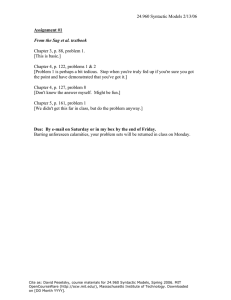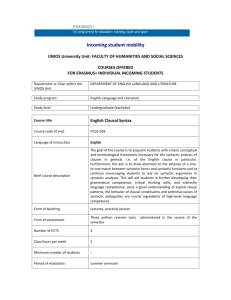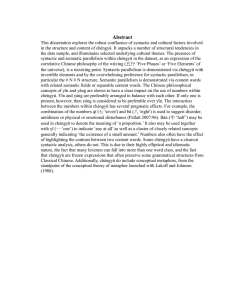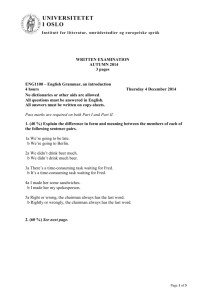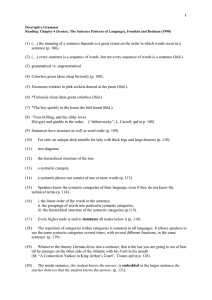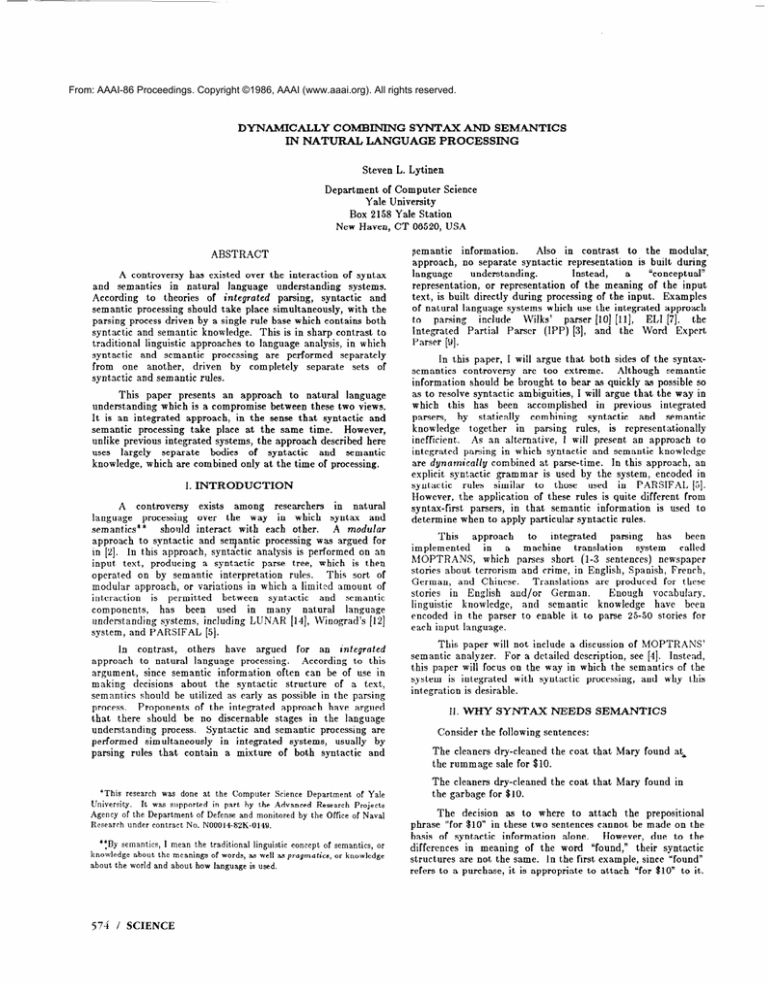
From: AAAI-86 Proceedings. Copyright ©1986, AAAI (www.aaai.org). All rights reserved.
DYNAMICALLY
COMBINING
SYNTAX
AND SEMANTICS
IN NATURAL LANGUAGE
PROCESSING
Steven
L. Lytinen
Department
of Computer
Science
Yale University
Box 2158 Yale Station
New Haven, CT 00520, USA
ABSTRACT
A controversy
has existed over the interaction
of syntax
and semantics
in natural
language
understanding
systems.
parsing,
syntactic
and
According
to theories
of integrated
semantic
processing
should take place simultaneously,
with the
parsing process driven by a single rule base which contains
both
syntactic
and semantic
knowledge.
This is in sharp contrast
to
traditional
linguistic
approaches
to language
analysis,
in which
syntact,ic
and semantic
processing
are performed
separately
from
one another,
driven
by completely
separate
sets of
syntactic
and semantic
rules.
This paper
presents
an approach
to natural
language
understanding
which is a compromise
between these two views.
It is an integrated
approach,
in the sense that syntactic
and
semantic
processing
take place at the same time.
However,
unlike previous integrated
systems, the approach
described
here
uses
largely
separate
bodies
of syntactic
and
semantic
knowledge,
which are combined
only at the time of processing.
I. INTRODUCTION
A controversy
exists
among
researchers
in natural
language
processing
over
the
way
in which
syntax
and
should
interact
with each other.
A modular
semantics* *
approach
to syntactic
and seyantic
processing
was argued for
in [Z]. In this approach,
syntactic
analysis
is performed
on an
input
text, producing
a syntactic
parse tree, which
is then
operated
on by semantic
interpretation
rules.
This sort of
modular
approach,
or variations
in which a limited amount
of
interaction
is permitted
between
syntactic
and
semantic
components,
has
been
used
in many
natural
language
understanding
systems,
including
LUNAR [14], Winograd’s
[la]
system, and PARSIFAL
[5].
In contrast,
others
have
argued
for
an integrated
approach
to natural
language
processing.
According
to this
argument,
since semantic
information
often can be of use in
making
decisions
about
the syntactic
structure
of a text,
semantics
should be utilized as early as possible in the parsing
process.
Proponents
of the integrated
approach
have argued
that
there should
be no discernable
stages
in the language
understanding
process.
Syntactic
and semantic
processing
are
performed
simultaneously
in integrated
systems,
usually
by
parsing
rules that
contain
a mixture
of both syntactic
and
*This research was done at the Computer Science Department of Yale
University.
It was supported in part by the Advanced Research Projects
Agency of the Department of Defense and monitored by the Office of Naval
Research under contract No. N0001482K-0139.
*fBy semantics, I mean the traditional linguistic concept of semantics, or
knowledge about the meanings of words, as well as progmatics, or knowledge
about the world and about how language is used.
574
/ SCIENCE
pemantic
information.
Also
in contrast
to t,he modular,
approach,
no separate
syntactic
representation
is built during
understanding.
Instead,
a
‘conceptual”
language
representation,
or representation
of the meaning
of the input
text, is built directly during processing
of the input.
Examples
systems which use the integrated
approach
of natural
language
to
parsing
include
Wilks’
parser (lo] (111, ELI [7].
the
Integrated
Partial
Parser
(IPP) [3], and the Word
Expert
Parser [9].
In this paper, I will argue t,hat both sides of the syntaxsemantics
controversy
are too extreme.
Although
semantic
information
should be brought
to bear as quickly as possible so
as to resolve syntactic
ambiguities,
I will argue that the way in
which
this
has been
accomplished
in previous
integrated
by
statically
combining
syntactic
and
semantic
parsers,
knowledge
together
in parsing
rules,
is representationally
As an alternative,
I will present
an approach
to
inefficient.
integrated
parsing
in which syntactic
and semantic
knowledge
are dynamically
combined
at parse-time.
In this approach,
an
explicit syntactic
grammar
is used by the system,
encoded
in
syntactic
rules
similar
to those
used
in PARSIFAL
[5].
However,
the application
of these rules is quite different
from
syntax-first
parsers,
in that
semantic
information
is used to
determine
when to apply particular
syntactic
rules.
approach
to
integrated
parsing
has
been
This
machine
translation
system
called
implemented
in
a
MOPTRANS,
which
parses
short (1-3 sentences)
newspaper
stories about terrorism
and crime, in English,
Spanish,
French,
Translations
are produced
for these
German,
and Chinese.
stories
in English
and/or
German.
Enough
vocabulary,
linguistic
knowledge,
and
semantic
knowledge
have
been
encoded
in the parser to enable it to parse 25-50 stories for
each input language.
This paper will not include a discussion
of MOPTRANS’
semantic
analyzer.
For a detailed description,
see [4]. Instead,
t,his paper will focus on the way in which t,he semantics
of the
system
is integrated
with syntactic
processing,
and why this
integration
is desirable.
II. WKY
Consider
SYNTAX
the following
The cleaners
the rummage
IVEEDS
sentences:
dry-cleaned
the coat
sale for $10.
The cleaners dry-cleaned
the garbage
for $10.
SEMANTICS
the coat
that
Mary
found
ats
that
Mary
found
in
The decision
as to where to attach
the prepositional
phrase “for $10” in these two sentences
cannot be made on the
basis of syntactic
information
alone.
However,
due to the
differences
in meaning
of the word
“found,n
their syntactic
structures
are not the same.
In the first example, since “found”
refers to a purchase,
it is appropriate
to attach
“for $10” to it.
However,
in the second sentence,
since it does not make sense
to find something
in the garbage
for $10, the prepositional
phrase must attach to “dry-cleaned.”
In syntax-first
parsing,
then,
the resolution
of some
syntactic
ambiguities
must
be
delayed
until
semantic
interpretation.
There is a computational
price to pay for this,
because often an unresolved
syntactic
ambiguity
can affect the
complexity
of subsequent
syntactic
analysis.
For example:
The cleaners dry-cleaned
the coat that Mary found in
the garbage
for $10 while she was away in New York.
If semantics
is used
immediately
to
resolve
the
attachment
of “for $10” to the verb “dry-cleaned,”
then there
is no ambiguity
as to where to attach the clause “while she was
away in New York.”
However,
if the PP attachment
is not
resolved
immediately,
then it is also possible
to attach
this
clause to “found.”
Thus, putting
off the resolution
of the first
ambiguity
would result
in a syntax-first
parser
finding
this
sentence
to be 3-way
ambiguous.
The. third
interpretation
would not even have to be considered
in an integrated
parser.
Carrying
forward
ambiguities
in syntactic
analysis
that
could
be resolved
in an integrated
parser
can cause
a
combinatorial
explosion
in the number
of syntactic
ambiguities
that must be considered
as the parse continues.
For example,
consider the following sentence:
The stock
the stands
cars raced by the spectators
at over 200 mph on the track
crowded
at Indy.
into
This sentence
is highly ambiguous
syntactically,
due to
the fact
that
either
“raced”
or “crowded”
could
be the
sentence’s
main verb,
and the prepositional
phrases
in the
sentence
could be attached
in many
different
ways.
In a
syntax-first
parser,
these ambiguities
would cascade.
resulting
in an increasingly
large number
of interpretations
that would
have to be considered
during
the course
of the parse.***
However,
the use of semantics
drastically
reduces the number
of syntactic
ambiguities
that
would
have to be considered.
Semantics
can tell us that
“raced”
in this sentence
must be
active, because
it is unlikely
that spectators
would race stock
This fact
also resolves
the syntactic
ambiguity
of
cars.
This, in turn,
since both verbs cannot
be active.
“crowded,”
attachments
from
many
prepositional
phrase
eliminates
consideration.
As this example
demonstrates,
the price for
syntactic
and semantic
processing
can be quite
Unresolved
syntactic
ambiguities
computationally.
on each other, resulting
in the need to consider many
attachments
which would be eliminated
if semantic
were done in parallel.
III. WHAT’S
WRONG
INTEGRATED
separating
expensive
can build
syntactic
processing
WITH
PREVIOUS
PARSERS?
In
order
to
bring
semantics
into
the
understanding
process as early as possible,
previous
and
semantic
compiled
syntactic
systems
have
language
integrated
knowledge
***For instance, in a left-to-right syntactic parse of this sentence, there
would be 12 ways to attach the PP “at over 200 mph.” Considering only
syntax, the 2 verbs could be parsed in 4 ways (either one active, both part of
unmarked relative clauses attaching to “cars,” or the second relative clause
Then, for each of these 4 interpretations, there
attaching to “spectators”).
are 5 possible places to attach the PP:
to Vars,” ‘raced,” “spectators,”
“crowded,” or “stands.n This makes 20 possible attachments, 7 of which
could be eliminated by various constraints on where PP’s can be attached.
The combinatorics are even worse for the subsequent PP’s in the sentence.
Although
this sort of integration
together
into one set of rules.
accomplishes
the goal of utilizing semantic
information
early on
in the parsing process, storing parsing knowledge
in this form is
highly inefficient.
First,
the
combination
of syntactic
and
semantic
information
in the parser’s rule base results in the inability
to
apply
to syntactic
categories
in
write
parsing
rules which
Consider
some of the parsing
rules used in the
general.
of ELI. Like ELI,
Conceptual
Analyzer
(CA) (11, a descendant
much of CA’s parsing
knowledge
was encoded
in the form of
requests
[6], or test-action
pairs, which were stored mainly
in
the parser’s lexicon.
Requests
were used to build a conceptual
representation
of an input text as the parse proceeded.
One of
the t,asks in building
a representation
was to fill the slots of a
representational
structure
with the appropriate
fillers.
For
example,
to parse the sentence
“Fred gave Sally a book,” CA
built the representation
(ATRANS
ACTOR
FRED OBJECT
BOOK
RECIPIENT
SALLY),
where
ATRANS
was
the
Conceptual
Dependency
(CD) (81 primitive
meaning
“transfer
of
control of an object.”
To fill in the ACTOR
of this action with
FRED, CA used the following request:
Look back for a noun group which has the
“Gave” request:
semantic property
ANIMATE, which is not the object of a
preposition, or the object of a verb, or attached syntactically
Place the conceptualization
in the
to anything
before it.
ACTOR slot of the ATRANS.
Most other verbs in CA had similar requests,
looking for a
noun group of a certain semantic
type before the verb, with the
same syntactic
restrictions
on this noun group, to fill a slot in
This slot was not
the conceptualization
built by the verb.
always the ACTOR
slot, as it was for “gave.” For example, the
RECIPIENT
of an ATRANS
preceded
the verb
“received.n
still shared
much of the
However,
the request
for “received”
same information:
“Received” request:
Look back for a noun group which has the
property
ANIMATE, which is not attached
syntactically
to
Place the conceptualization
in the
anything
before it.
RECIPIENT slot of the ATFZANS built by “received.”
These requests,
as well as similar requests
stored in the
dictionary
definition
of every verb in CA’s dictionary,
all shared
namely,
that the subjects
of
common
syntactic
information:
and are not syntactically
attached
to
verbs
precede
them,
Thus,
it would
be much
more
anything
before
them.
economical
to store this common
information
in only one rule,
it in countless
verb-specific
rules.
rather
than
duplicate
However,
because this syntactic
information
was combined
with
semantic
information
about
the particular
slot filled by the
subject
for each particular
verb, and the semantic
constraints
on what the subject could be, this syntactic
information
had to
be duplicated
over and over again.
Another
problem
with previous
integrated
systems
and
the lack of autonomy
of syntax in these systems is evident if we
examine
the way in which these parsers
attempted
to resolve
Consider
the way in
certain
types of syntactic
ambiguities.
which
CA resolved
the syntactic
ambiguity
in the following
sentence:
A small
crashed.
plane
stuffed
with
1500 pounds
of marijuana
can
function
as either
a past
The
word
“stuffed”
participle
or a past active verb.
To resolve this ambiguity,
CA
used a request
which
looked for the word
“with” appearing
“stuffed”
was treated
as
If it was found,
“stuffed.”
after
passive,
and the NP to the left of the verb (in this case
NATURAL
LANGUAGE
/ 575
“plane”)
was the OBJECT
being stuffed.
This request,
if it
fired, also activated
another
request
which looked for another
verb further on in the sentence,
marking
the end of the relative
clause.
This request,
and other
requests
used to resolve other
types of syntactic
ambiguities,
used focal syntactic
information
in order to perform
disambiguation.
By this, I mean that only
words in the immediate
neighborhood
of the ambiguity
were
checked for particular
syntactic
properties,
or for their presence
or absence.
In this case, the presence
of the word
“with”
immediately
after the verb was the local information.
The
advantage
of this was that it was not necessary
for the parser
to keep track
of a separate
syntactic
analysis.
Syntactic
ambiguities
were resolved by examining
shortterm
memory
to
see what words were there or what semantic
constituents
had
been built.
However, it is not always the case that these sorts
checks are enough.
Consider the following examples:
of local
1 Find
possible
1 betueen
/\
I
I
/Are\
/there\
l
\ any /
I
I
/I\
I
IV. A PARSER
WHICH
SATISFIES
BOTH
CONSTRAINT’S
The MOPTRANS
parser overcomes
the difficulties
that I
have outlined
in the last two sections.
MOPTRANS
is an
in the sense that syntactic
and semantic
integrated
parser,
processing
take place in tandem.
However,
it is different
from
in that
it
uses
a largely
integrated
parsers,
previous
syntactic
rules,
and
a
syntactic
autonomous
set
of
representation
of the input
text
is built
during
parsing.
MOPTRANS
uses PARSIFAL-like
parsing
rules [5], which
specify how sequences of syntactic
constituents
in the input text
can be attached
to each othei.
However,
unlike PARSIFAL
syntax
rules in MOPTRANS
are
and other syntactic
parsers,
only considered
and applied
if the syntactic
attachments
that
they make are judged
by the parser’s semantic
analyzer
to be
In this way, syntactic
and semantic
semantically
appropriat,e.
processing
are completely
integrat,ed.
As MOPTRANS
parses a piece of text, the semantic
and
syntactic
representations
that it builds are kept in its active
memory.
During parsing,
new constituents
are added to active
576
/ SCIENCE
1
memory
1
--------
"o-->--------
\?/
\/
\I/
I
I
yes
I
-----------_-------------I
/I\
I
I
Choose
Rbestm
connection
________----_~~~--_----~~~
I
I
\I/
I
I
I
I
___------_____------________
I Find
/I\
syntactic
rules
semantic
actlons
1 UIII
make
this
-_-----------_-----____L____
I
connectton
------_----____
I
I
I Choose
I
------------1 Remove
the
a
pattern
rule
is
uhose
I
also
the
I Ilst
of
1 <---no---
/there\
I possible
I
\
I connections
I
Figure
memory
1:
1
-------
-------_
---__----_____-_-_
\
one
I
I
\I/
/\
/Is
syntactic
I patterns
I
1 from
I
rule
Indexing
I via
I
syntactic
satisfied
by
--------__________-------------
I
I
I connectlon
a
I Select
_-------~------________________
I
it
appears
that
some
syntactic
In
general,
then,
ambiguities
cannot
always
be resolved
by using only local
This is because
the resolution
of syntactic
syntactic
checks.
ambiguities
sometimes
requires
more global
knowledge
about
the syntax
of a sentence,
such as whether
a particular
verb
functions
as the main clause verb.
Information
like this cannot
be determined
so easily by rules which examine only immediate
Thus,
although
we would
like for syntactic
and
context.
semantic
processing
to be integrated,
it seems that a separate
syntactic
representation
must
be built during
the analysis
process in order to resolve some types of ambiguities.
connections
active
----------------------->I
The slave boy traded for a sack of grain.
I saw the slave boy traded for a sack of grain.
In these cases, the appearance
of a preposition
after the
verbs “called” and “traded”
does not guarantee
that the verbs
are passive.
This is because
both verbs can be used either
transitively
or intransitively.
Instead,
the information
that
must be used to determine
whether
the verbs are active
or
passive is whether
or not there is another
verb in the sentence
which functions
as the main verb.
However,
since CA did not
keep track
of more
global
syntactic
information
such
as
whether
a particular
verb functioned
as the main verb of the
sentence,
it would be much more difficult
to write requests for
these examples.
in
I
1 whose
The soldier called to his sergeant.
I saw the soldier called to his sergeant.
semantic
concepts
---yes--->
I Execute
the
rule
1
/
\?I
Interaction Between Syntax: and Semantics in MOPTRANS
as each
new
word
is read.
As new
constituents
are
added,
semantics
is asked if anything
in active memory
“fits
together”
well; that is, if there are any semantic
attachments
that could be made between the elements
in active memory.
If
so, MOPTRANS’
syntactic
rules are consulted
to see if any of
these semantic
attachments
are syntactically
legal.
In other
words, semantics
proposes various attachments,
and syntax acts
as a filter, choosing
which of these attachments
makes sense
The interaction
between
according
to the syntax of the input.
graphically
in Figure
syntax and semantics
is displayed
simple
To make
sentence
John
gave
this more clear, consider
is parsed by MOPTRANS:
Mary
how
the
following
a book.
MOPTRANS’
dictionary
definitions
contain
information
about
what semantic
representation
the parser
should
build
when it encounters
a particular
word.
Thus, “John” causes the
representat,ion
PERSON
to appear
in the parser’s
active
At the same time, since “John” is a proper noun, the
memory.
syntactic
class NP is also activated.
When
the
word
“gaven
is processed,
MOPTRANS’
definition
of this word causes the CD representation
ATRANS
to be placed in active memory.
At this point, MOPTRANS
considers
the two semantic
representations
in active memory,
The semantic
analyzer
tries to
PERSON
and ATRANS.
combine
these representations
in whatever
way it can.
It
concludes
that the PERSON
could be either the ACTOR
or the
RECIPIENT
of the ATRANS,
since the constraints
on these
roles are that they must be ANIMATE.
It also concludes
that
the PERSON
could be the OBJECT
of the ATRANS
(that is,
the thing
whose
control
or possession
is being transferred).
However,
since this role is expected
to be a PHYSICAL
OBJECT
rather than an ANIMATE,
the match is not as good
as with the ACTOR
or RECIPIENT
roles.****
This is the point at which the MOPTRANS
parser utilizes
Semantics
has determined
that 2 possible
its syntactic
rules.
Now the parser
examines
its
attachments
are preferred.
syntactic
rules to see if any of them could yield either of these
Indeed, the parser’s Subject Rule will assign the
attachments.
PERSON
to be the ACTOR
of the ATRANS.
The Subject
Rule looks like this:
Subject Rule
Syntactic pattern:
Additional restrictions:
Syntactic assignment:
Semantic action:
Result:
NP, V (active)
NP is not already attached
syntactically
NP is SUBJECT of V, V is
indicative (V-IND)
NP is ACTOR of V (or another
slot, if specified by V>
V-IND
This rule applies when an NP is followed
by a V, and
when
the NP can fill the ACTOR
slot of the semantic
representation
of the V. The NP is marked
as the SUBJECT
of
the V, and the V is marked as indicative
(V-IND).
As dictated
by the RESULT
of the rule, the V-IND
is left in active
but the NP is removed,
since its role as subject
memory,
prevents
many
subsequent
attachments
to it, such as PP
In addition
to these syntactic
assignments,
the
attachments.
semantic
representation
of the NP “John”
is placed
in the
ACTOR
slot of the ATRANS
representing
the verb.
To
The rest of the sentence is parsed in a similar fashion.
determine
how “Mary” should be attached
to ‘gave,” semantics
is asked for its preference.
Just as with ‘John,”
“Mary” fits
well into the ACTOR
or RECIPIENT
slots. Since “John” has
already
been selected
as the ACTOR,
semantics
chooses the
RECIPIENT
slot for “Mary.” Syntax is consulted
to see if any
syntactic
rules can make this attachment.
This time, the
Dative Movement
rule is found:
Dative Movement Rule
Syntactic pattern:
Additional restrictions:
Syntactic assignment:
Semantic action:
Result:
V-IND, NP
V-IND allovs dative movement
NP is INDIRECT OBJECT of V-IND
NP is (semantic) RECIPIENT of
V-IND (or another slot, if
specified by V-IND)
V-IND, NP
IVhen applied,
this rule assigns
“Mary”
as the indirect
object
of “gave,”
and places
the PERSON
concept
which
represents
‘Mary” into the RECIPIENT
slot of the ATRANS.
The final NP in the sentence,
“the book,” is attached
to
Ugaven in a similar way.
Semantics
is asked to determine
the
best
att,achment
of
“book,”
which
is represented
as a
PHYSICAL-OBJECT,
to other
concepts
in active
memory,
which at this point contains
the ATRANS
as well as the person
representing
“Mary.”
Semantics
determines
that
the
best
attachment
is to the OBJECT
role of the ATRANS.
The
syntactic
rule which can perform
this attachment
is the Direct
Object rule, which is similar in form to the Dative Movement
rule above.
This rule is applied,
yielding
the final semantic
representation
(ATRANS
ACTOR
PERSON
OBJECT
PHYSICAL-OBJECT
RECIPIENT
PERSON),
and
the
****The way in which the semantic analyzer reaches these conclusions wiII
not, be discussed in thispaper. For more details,
see[4].
syntact,ic
markings
as its direct object,
of “John” as the subject of “gave,”
and “Mary” as its indirect object.
“book”
One important
thing to note about the parsing process on
this sentence
is that
although
the Direct Object
Rule could
have applied
syntactically
when “Mary”
was found after the
verb,
it was never even considered.
This is because
the
semantic
analyzer
preferred
to
place
“Mary”
in
the
RECIPIENT
slot of the ATRANS.
Since a syntactic
rule was
found which accomodated
this attachment,
namely the Dative
Movement
rule, the parser
never tried to apply
the Direct
0 bject rule.
The lllOPTRANS
parser
is able to resolve
syntactic
ambiguities
that
proved
difficult
for past integrated
parsers.
For the sentence
discussed
earlier,
“I saw the soldier called to
his sergeant,”
MOPTRANS
has no trouble
determining
that
“called”
is an unmarked
passive,
because
according
to its
syntax
rules,
another
indicative
verb at this point
is not
possible.
The rule which is applied
instead
is the Unmarked
Passive rule:
Unmarked Passive Rule
Syntactic pattern:
Syntactic assignment:
Semantic action:
Result:
NP, VPP
NP is (syntactic) SUBJECT of
VPP, VPP is PASSIVE, VPP is
a RELATIVE CLAUSE of NP
NP is (semantic) OBJECT of S (or
another slot, if specified by VPP)
NP, VPP
“Called”
is represented
by the Conceptual
primitive
MTRANS,
which is used to represent
communication.
Since “soldier” can be attached
Dependency
any form of
as either the
ACTOR
or the OBJECT
of an MTRANS,
semantics
would be
happy with either of these attachments.
However, the Subject
Rule cannot
apply
at this point,
since “soldier”
is already
attached
as the syntactic
direct object
of “saw.” Thus, this
restriction
on the Subject
Rule prevents
this attachment
from
being made.
Instead,
the Unmarked
Passive Rule applies, since
it semantically
attaches
“soldier”
as the OBJECT
of the
MTRANS,
and since “called” is marked
as potentially
being a
past participle
(VPP).
Unlike syntax-first
parsers,
the MOPTRANS
parser can
immediately
resolve
syntactic
ambiguities
on the basis of
semantic
analysis,
thereby
cutting
down on the number
of
syntactic
attachments
that it must consider.
We have already
seen this in the example,
“John gave Mary the book,” in which
the parser does not even consider if “Mary” is the direct object
of “gave.” Let us return now to two examples discussed earlier:
The cleaners dry-cleaned
the garbage
for $10.
The cleaners
the rummage
found”
the coat
that
Mary
found
in
dry-cleaned
the coat
sale for $10.
that
Mary fouDd
at
MOPTRANS
parses
the
with the following rule:
relative
clause
“that
Mary
Clause Rule for Gap After the Verb (CGAV Rule)
Syntactic pattern:
Additional restrictions:
Syntactic assignment:
Semantic action:
NP, RP (relative pronoun)
(optional), V-IND
V-IND is not followed by a NP
V-IND is a RELATIVE CLAUSE of NP
NP is the semantic OBJECT of
the V-IND
NATURAL
LANGUAGE
f 5”
NP, V-IND (changed to CLAUSE-VERB)
Result:
“Mary”
to be the subject
of
The Subject
Rule assigns
is not yet attached
syntactically
to
“found ,” since ‘Mary”
Then, since no NP follows
Yfound,n and
anything
before it.
since the attachment
of “coat” (a PHYSICALOBJECT)
as the
OBJECT
of the ATRANS
is semantically
acceptable,
the
“that Mary found” as a relative
CGAV rule applies, assigning
clause.
MOPTRANS
parser
is integrated,
in that
syntactic
and
has a
semantic
processing
proceed in parallel, but MOPTRANS
separate
body
of
syntactic
knowledge,
and
builds
a
representation
of the syntactic
structure
of input
sentences.
This
enables
it to
use
semantics
to resolve
syntactic
ambiguities,
and to easily
resolve
ambiguities
that
cause
difficulties
for local syntax-checking
rules.
“for $10” in the first example
When the parser reaches
above, the representations
of “dry-cleaned”
and ‘found”
are
The NP “810” is represented
as
both still in active memory.
The
preposition
“for”
also
has
a semantic
MONEY.
representation,
which describes
the possible semantic
roles that
a PP beginning
with “for” can fill. One of these roles is called
“Dry-cleaned”
is represented
by the
IN-EXCHANGE-FOR.
concept
PROFESSIONAL-SERVICE,
which expects to have its
IN-EXCHANGE-FOR
role filled with MONEY,
since most
professional
services
are done for money.
ATRANS,
on the
other hand, does not explicitly
expect an IN-EXCHANGE-FOR
role.
Thus, semantics
prefers to attach
the PP “for $10” to
PROFESSIONAL-SERVICE
and the verb “dry-cleaned.n
1. Birnbaum,
L., and Selfridge, M. Problems
in Conceptual
Analysis of Natural
Language.
Tech. Rept. 168, Yale
University
Department
of Computer
Science, October,
1979.
In the second example,
on the other hand, when the PP
“at the rummage
sale” is attached
to “found,n this triggers
an
inference
rule that the ATRANS
representing
“found”
must
actually
be the concept
BUY, since “rummage
sale” is a likely
BUY, like PROFESSIONALSERVICE,
setting for this action.
expects
the role
IN-EXCHANGE-FOR
to be filled
with
MONEY.
Thus, semantics
has no preference
as to which verb
to attach
“for $10” to. To resolve the ambiguity,
a syntactic
attaching
“for $10” to
recency
preference
is used, thereby
‘found.”
4. Lytinen,
S. The Organization
Ph.D.
lingual, Integrated
Parser.
Department
of Computer
Science,
Because of this resolution
of ambiguity,
the MOPTRANS
parser does not have to consider
ambiguities
further
on in the
sentence
that it might otherwise
have to. For example,
in the
“The cleaners dry-cleaned
the coat Mary found in the
sentence,
garbage
for $10 while she was away in New York,” the PP
attachment
rule
which
MOPTRANS
uses
removes
the
from active memory,
since the PP
representation
of “found”
attaches
to something
before the clause containing
‘found.”
Therefore,
when the parser reads “while she was away In New
York,” there is only one possible verb, “dry-cleaned,n
to which
this clause can be attache&
V. CONCLUSION
In this paper I have argued
that semantic
and syntactic
By this, I mean that syntactic
analysis
should be integrated.
and semantic
processing
must proceed at the same time, relying
on each other to provide information
necessary
to resolve both
Non-integrated,
syntaxsyntactic
and semantic
ambiguities.
first parsers
must leave some syntactic
ambiguities
unresolved
until the semantic
analysis
st’age.
This can result in a highly
inefficient
syntactic
analysis,
because the failure to resolve one
syntactic
ambiguity
can lead to other,
“artificial”
syntactic
ambiguities
which would not have to be considered
had the
These new
original
ambiguity
been resolved
with semantics.
ambiguities
may also be unresolvable
using only syntax.
If
several of these ambiguities
are encountered
in one sentence,
the combinatorics
of the situation
can get out of hand.
parsers
have
avoided
these
integrated
Previous
inefficiencies,
but have suffered
from problems
of their own.
Because
of the lack of a separate
representation
of the input
text’s syntactic
structure,
these parser
must rely on ‘localn
Some
syntax-checking
rules to resolve syntactic
ambiguities.
types of ambiguities
cannot easily be resolved with local checks.
To solve
5’23
both
/ SCIENCE
of these
problems
at the
same
time,
the
REFERENCES
2. Chomsky,
N..
Press, Cambridge,
A8peCt8
Mass.,
of the Theory of Syntaz.
1965.
MIT
3. Lebowitz,
M. Generalization
and Memory in an
Integrated
Understanding
System.
Ph.D. Th., Yale University,
October
1980. Research
Report #lSS
of Knowledge
in a MultiTh., Yale University,
November
1984.
Recognition
for
5. Marcus, M. A Theory of Syntactic
Ph.D. Th., Massachusetts
Institute
of
Natural
Language.
Technology,
February
1978.
6. Riesbeck,
In formation
C. Conceptual
Analysis.
Processing,
North-Holland,
In Conceptual
Amsterdam,
1975.
7. Riesbeck,
C., and Schank, R.C. Comprehension
by
Computer:
Expectation-based
Analysis of Sentences in Context.
Tech. Rept. 78, Yale University
Department
of Computer
Science, October,
1976.
8. Schank, R.C.
Natural
Language
(1972), 552-631.
“Conceptual
Dependency:
A Theory of
Understanding.”
Cognitioe
Psychology
3, 4
Word Expert Parsing:
A Theory of
9. Small, Steven.
Diatributed
Word-baaed Natural Language
Undercltanding.
Ph.D. Th., Department
of Computer
Science, University
of
Maryland,
1980.
10. Wilks, Y. An Artificial
Intelligence
Approach
to Machine
Translation.
In Computer
Modela of Thought and Language,
Schank, R., and Colby, K., Ed.,W.H.
Freeman
and Co., San
Francisco,
1973, ch. 3, pp. 114-151.
11. Wilks, Y. “A Preferential,
Pattern-matching,
for Natural
Language
Understanding.”
Artificial
6, 1 (1975).
12. Winograd,
T.. Understanding
Academic
Press, New York, 1972.
Natural
Semagtics
Intelligence
Language.
13. Woods, W., Kaplan,
R., and Nash-Webber,
B. The Lunar
Sciences Natural
Language
Information
System:
Final Report.
Tech. Rept. 2378, Bolt, Beranek and Newman,
Inc., 1972.



